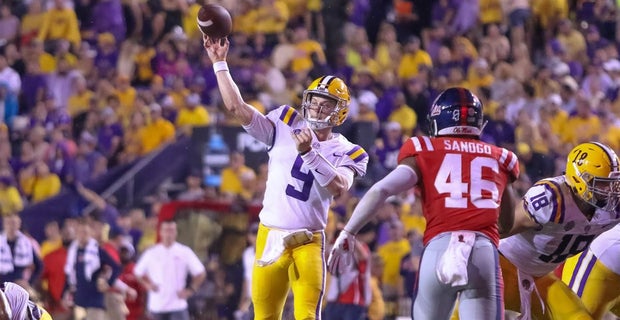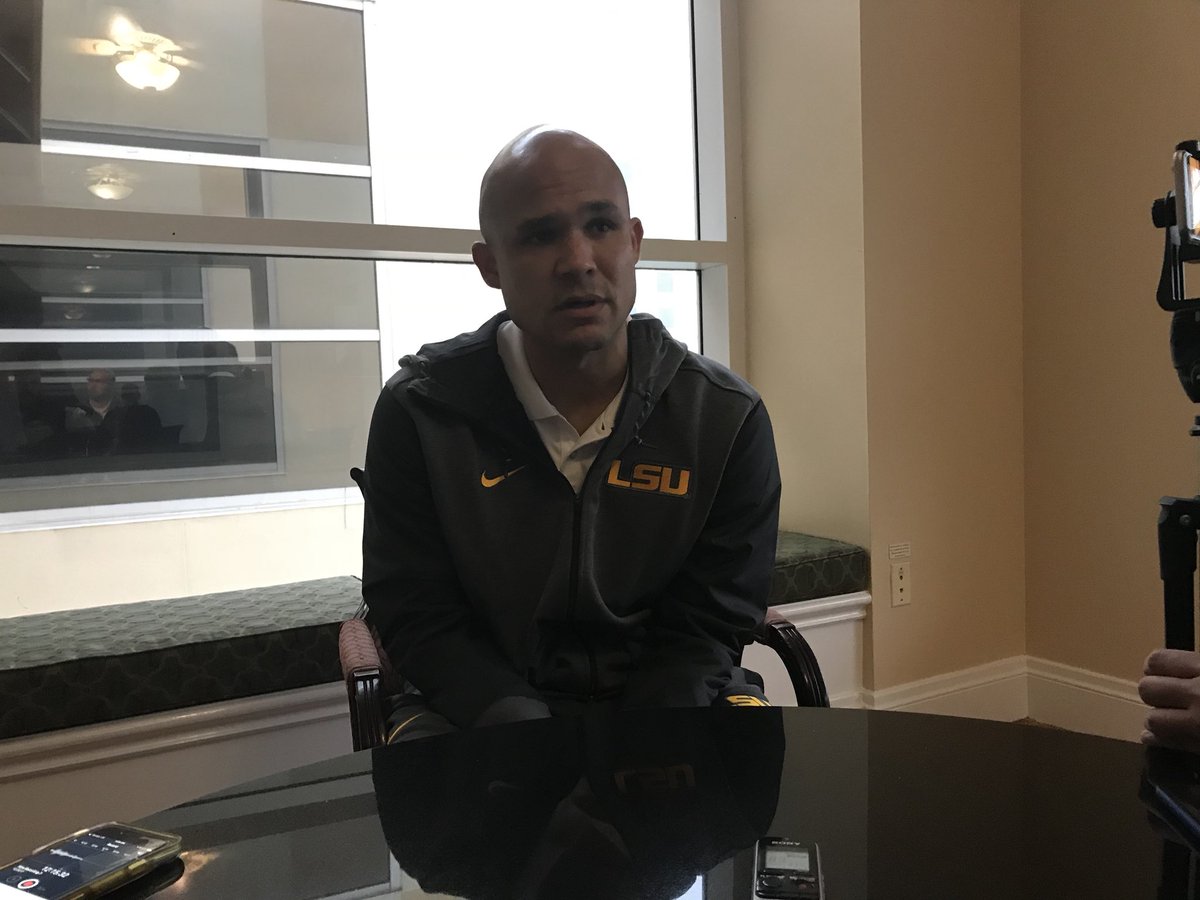
By CODY WORSHAM | Tiger Rag Editor
This is the second in a (hopefully) season long look into LSU’s quarterback play. I’ll be charting every throw made by an LSU quarterback in 2017, with as much detail as possible. If you’d like any particular aspect of the Tigers’ passing game analyzed, comment below or hit me up on Twitter, and I’ll track it. This week: the deep ball.
ICYMI: Week One: First down success vs. BYU
Much of the preseason talk surrounding Matt Canada’s new offense at LSU was how it would stretch defenses horizontally using his beloved jet sweep.
There was less focus, however, on Canada’s emphasis on stretching defenses vertically with the deep ball. He’s saved that one for the field.
Both the stats and the eye test reveal just how much more Danny Etling is throwing the ball deep this season. Through two weeks, he leads the SEC and ranks fourth nationally in yards per attempt (12.8), nearly five yards more than his average last year (7.9, fifth in the SEC and 32nd nationally) and well over double his average in two seasons at Purdue (5.8).
It’s not dissimilar to what happened at Pittsburgh last year for Nathan Peterman under Canada. Peterman ranked sixth nationally in yards per attempt (9.3), two yards better than he posted the previous season before Canada’s arrival. In total, Pittsburgh ranked fifth nationally in completions of 20+ yards.
Canada’s carried that emphasis on the home run ball with him to Baton Rouge. It’s only two games, and not exactly against the stiffest competition LSU will face all year, but what LSU has done on the deep ball in a very limited sample size is remarkable. Here are Etling’s numbers on targets of 20+ yards, from my spreadsheet charting all of his throws this season. (Note: I limited the scope to targets of 20+ yards to eliminate any noise from short completions made longer by yards after catch; this eliminated, for example, the JaCoby Stevens catch for 27 yards, which was a 19-yard target.)
Etling on Attempts of 20+ Yards
[table]
Completions, Attempts, Percentage, Yards, TDs, INTs, Passer Rating
6, 6, 100%, 260, 1, 0, 519 [/table]
Against Chattanooga, LSU’s long-range aerial attack was on full display. Etling connected on all four attempts beyond the 20-yard mark for 176 yards and a score. Three of the four were play action, three of the four came from under center, and three of the four were throws down the middle of the field.
Etling’s Attempts of 20+ vs. Chattanooga
[table]
Down, Distance, Formation, Play Action, Direction of Throw, Distance of Target, Time of Release, Number of Rushers
2nd, 4, Ace, Y, Middle, 36 yards, 3.5 seconds, 5
1st, 10, Ace, Y, Middle, 46 yards, 3.58 seconds, 6
2nd, 13, Shotgun, N, Right, 42 yards, 3.32 seconds, 4
2nd, 8, Ace, Y, Middle, 48 yards, 3.68 seconds, 3
Average, , , , , , ,
1.75, 8.75, 75% Ace, 75% Play Action, 75% Middle, 43 yards, 3.52 seconds, 4.5
[/table]
The best throw of the bunch was a 48-yarder to Chark down the right sideline, which was also the aberration of the group. It was the lone throw to the right, the lone shotgun call, and the lone deep throw without play action. Watch how Etling manipulates the safety with his eyes to create the space in which to drop the ball for Chark, before putting a dime into 7’s hands.
The key to the deep ball is the time it takes. Etling needs protection to buy the 3.5 seconds he’s using to let the play develop. There were times against Chattanooga where pressure got to Etling – either by the fault of the line or Etling himself – and disrupted a potential deep shot.
On one play action attempt, a simple delayed blitz catches LSU’s line sleeping, but Etling also misses a wide open D.J. Chark streaking across the middle of the field.
On another play, Derrius Guice picks up a blitz brilliantly, but Etling scrambled from feeling the pressure, when he might’ve stayed in the pocket to progress through the play.
There were also a couple of times Etling stepped up into the pocket nicely, only to sail the throw.
Those are easy corrections, though, and ones Etling was surely thinking about immediately after the game.
“I thought I was a little sporadic at times,” he said, after completing 8-of-14 passes for 227 yards and a 216.9 passer rating, the second-highest single-game rating of his career. “I was struggling as far as keeping my fundamentals. I knew it as soon as I did it…There’s some things I know I can fix. It’ll be an easy fix…This is some good film for us to watch.”
Red Zone, Third Down Numbers
Scroll through Etling’s numbers, and the only ones that aren’t superb so far are two critical areas: third down and red zone, where his passer ratings are 108.7 and 71.0, respectively.
On third downs, Etling’s twice thrown the ball away, meaning the defense has managed to cover or pressure well enough to force him to get rid of it. The clip above is a good example.
LSU is also not looking to throw downfield as much on third downs. Etling’s average distance of target (ADOT) on first downs is 16.9 yards, compared to 7.9 yards on third down. And yet, despite the shorter target distance, Etling is holding on the ball about a third of a second longer on third downs (3.03 seconds) than first (2.69 seconds), which points to marginal, but meaningful, hesitation.
In the red zone, the sample size is simply too small this season to draw many conclusions from (2-of-4 passing for 10 yards). One pass was into the flats to Darrel Williams against BYU, and he nearly scored. Had he, the figures would look much better.
The good news is Etling was at his best last year in the red zone. I expect he’ll progress back to the mean with more shots this season.





4 Trackbacks / Pingbacks